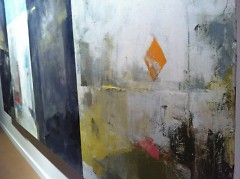I used to paint.
I used to paint huge color field paintings with layers and depth and I just really, for years on end, loved color and balance. Those two elements, simple and often disregarded as they may be in much artwork, can convey so much just on their own.
Megan Klco and Justin Kellner, with paintings across from each other at The SPOT in the Federal Square Building (29 Pearl St. NW), had not forgotten to consider these two basic elements and were able to transform them in powerful ways.
Kellner's "Cycle" uses muted and blended color in an abstracted landscape to convey a certain crisis in nature. It's not obvious: from across the way I'm drawn in by a beautiful scene. It looks so peaceful, from the other side of the room. And then I step closer and have, as I so often do with Kellner's work, a clear sense that something is not right. Something is disrupted, and the detailed goose in the painting seems a little at a loss for where to turn.
I wouldn't have to talk to Kellner to understand this-just a closer inspection gets me wondering about the disruption in the scene all on my own. It is not peaceful after all. Beautiful but definitely not peaceful. The color selections play a large part for Kellner.
"When I'm painting, I always pull out lots of different colors of paint, so [even though] I'm just always drawn towards neutral tones, I force myself to use bright colors," he says. "I'm always trying to balance between washes and the textures that I feel leads into the landscape, so it's a huge part of my abstract work is not just balancing the colors in composition, but actually letting the three dimensional surface of the painting let that balance as well."
Kellner's work is part abstracted landscape, part realism. The interplay between the two is something he focuses on, he says.
"If there's something that's realistic [in an abstracted painting] it can't just set on top of the painting. It's got to flow into it and be cohesive."
Klco's "Crisis of Indecision" doesn't have that same realism showing up in the abstracted landscape. In fact, she works hard to bury the references to the original cityscape she is working from.
"Lately I've been working a lot from cell phone pictures I'm taking while I'm moving. It allows me to gather a lot less information. So I'll work with that and move more and more towards abstraction. I'm burying things and obscuring things and I'm really interested in burying that image a little so that there's more mystery to the work," says Klco.
Her former work started as traditional plen air landscape painting.
"I worked with a group of painters in France who were really focused on plen air and what that meant in terms of resolving ourselves with our environment and how we interact with our environment. That's something that I've continued to think about and have been trying to translate into a more urban environment," says Klco.
Now, in an urban area instead of the fields of France, Klco finds herself still learning from her time with that group of painters in France.
"They were very focused on the reconciliation that can happen between a person and the environment that they are living in. They saw painting as an avenue in which to do that- in which to have relationship with your environment," says Klco. "I've found that living here, as opposed to, for example, frolicking in an olive grove in France, it's a little bit more difficult to have that same sort of relationship. When I experience my environment [in the city], it's usually in transit. I'm moving really quickly from one place to another. The crisis really [is] how I resolve myself to find a sense of place within an environment that's a lot more quickly moving, more fragmented."
That ability to take a fragmented environment and create an object of sheer beauty held my gaze and kept me looking. Both works convey a palpable crisis, whether it's in our own relationship with the environment as in Klco's work or the cycles within nature itself as in Kellner's case, in just the attention to color, balance and texture. Creating such complexity out of basic elements takes mastery, and both Klco and Kellner succeed in bringing us there.
They make me want to paint again.
The Rapidian, a program of the 501(c)3 nonprofit Community Media Center, relies on the community’s support to help cover the cost of training reporters and publishing content.
We need your help.
If each of our readers and content creators who values this community platform help support its creation and maintenance, The Rapidian can continue to educate and facilitate a conversation around issues for years to come.
Please support The Rapidian and make a contribution today.

